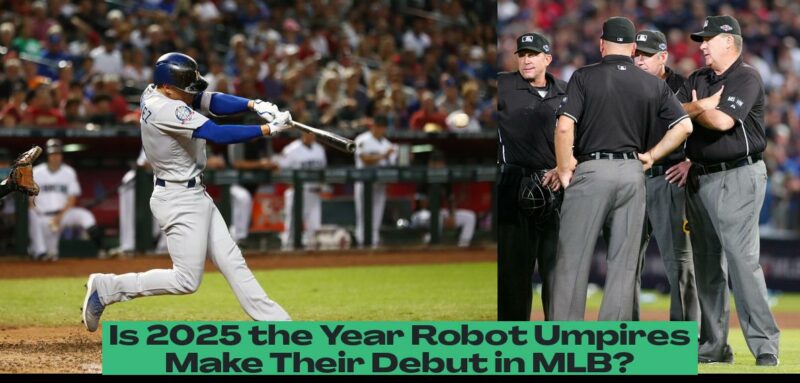The Robo-Ump Revolution: Is 2025 the Year We See Robot Umpires in MLB?
The baseball world is abuzz with speculation about the future of umpiring. It’s no secret that Major League Baseball has been exploring the use of automated ball-strike technology for years, and now, the whispers are getting louder. Commissioner Rob Manfred, in a recent interview, gave perhaps his strongest clue yet about a possible timeline for the debut of robotic umpires, suggesting that the technology is closer to major league implementation than ever before. He hinted at a 2025 spring training debut, sending shockwaves through the baseball community.
The prospect of robot umpires in MLB is a captivating one. It’s a bold step towards modernization and a potential solution to the perennial issue of human error in umpiring. While the technology has been tested and refined in the minor leagues, its arrival in the major leagues would be a historic moment, ushering in a new era of precision and objectivity in baseball.
However, the idea is not without its critics. Some argue that the human element of umpiring is vital to the game’s essence and that replacing umpires with robots would strip away a key aspect of the sport’s character. Others express concerns about the technology’s reliability and the potential for glitches that could disrupt the flow of the game. Still, the momentum behind robot umpires seems to be gathering steam, and it’s a topic that’s sure to be debated fiercely in the coming months.
So, what does this mean for the future of baseball? Could 2025 truly be the year we see robot umpires calling balls and strikes in MLB games? Only time will tell, but one thing is certain: the debate about robot umpires is far from over, and it’s a discussion that will continue to captivate fans, players, and everyone involved in the sport.
- MLB Commissioner hints at a possible 2025 spring training debut for robot umpires, signaling a potential major shift in umpiring technology.
- The introduction of robot umpires in MLB could bring about increased precision and objectivity, addressing the issue of human error in officiating.
- While the idea of robot umpires has its supporters, there are critics who argue that it could detract from the human element and character of the game.
- The development of automated ball-strike technology has been ongoing for years, with researchers and developers striving to perfect the system for implementation in major league games.
- The debate surrounding robot umpires is expected to intensify in the coming months, sparking discussions among fans, players, and stakeholders in baseball.
The Road to Robot Umpires: A Timeline of Innovation
The idea of robot umpires in MLB might seem like something straight out of a futuristic movie, but the reality is that the technology has been developing for quite some time. The journey towards automated ball-strike systems has been marked by a series of trials and tribulations, with researchers and developers working tirelessly to perfect the technology.
The journey began with the development of the Automatic Ball-Strike (ABS) system, which was first tested in minor league games in 2019. This initial trial was a significant step forward, but the technology was far from perfect. There were instances where the system struggled to accurately call pitches, leading to frustration among players and umpires alike.
Despite these initial challenges, the ABS system continued to evolve through a series of refinements and improvements. In 2022, the system was deployed in all 30 Triple-A parks, marking a major milestone in its development. This widespread implementation allowed for more extensive testing and data collection, further refining the technology and paving the way for its eventual arrival in the major leagues.
The success of the ABS system in Triple-A has fueled optimism about its potential for MLB implementation. The technology has proven its ability to accurately call balls and strikes, reducing the potential for human errors and enhancing the integrity of the game.
While the technology has come a long way, there are still some hurdles to overcome before it can be fully integrated into MLB games. One key challenge is ensuring that the system is reliable and accurate in a wider range of conditions, including different lighting, weather, and stadium environments. Another challenge is addressing the concerns of players, umpires, and fans about the potential impact of automated umpiring on the game’s traditions and the human element of competition.
Navigating the New Frontier: The Potential Impact of Robot Umpires on MLB
The introduction of robot umpires would undoubtedly represent a paradigm shift in the sport of baseball. It’s a move that would fundamentally change the dynamic between players, umpires, and fans. While some might view this as a positive development, others are apprehensive about the implications for the game’s cherished traditions and the human element of competition.
One of the most significant potential impacts of robot umpires would be the elimination of human error. Umpires, despite their best efforts, are human and are prone to making mistakes. This is an intrinsic part of the game, and it’s often seen as a source of both frustration and entertainment. Robot umpires, on the other hand, could theoretically eliminate these errors, providing a more objective and precise judgment of pitches.
However, the elimination of human error might also lead to a loss of spontaneity and unpredictability. Umpires are not simply robots; they are individuals who bring their own personalities and interpretations to the game. Sometimes, their decisions might seem controversial, but this is part of the game’s charm. Robot umpires, lacking the ability to exercise judgment and discretion, could potentially make the game more predictable and less engaging for fans.
Another potential impact is the effect on player-umpire interactions. The relationship between players and umpires is a complex one, often filled with tension and occasional outbursts. Robot umpires, lacking the ability to interact with players, could potentially decrease the drama and intensity of these interactions.
The introduction of robot umpires would undoubtedly be a significant change for MLB. It’s a move that would require careful consideration and a thoughtful approach to ensure that it doesn’t disrupt the game’s essential elements. It’s a decision that will shape the future of baseball, and one that will be closely watched by fans around the world.
The Arguments for and Against Robot Umpires: A Deeper Dive
The debate surrounding robot umpires is a complex one, with valid arguments on both sides. As the technology continues to develop and the possibility of its implementation in MLB becomes more concrete, the discussion will only intensify. Here’s a closer look at the key arguments for and against robot umpires, providing a comprehensive understanding of the issues at stake.
Arguments in Favor of Robot Umpires
Proponents of robot umpires argue that the technology offers several advantages that could significantly enhance the game of baseball. Here are some of the key arguments in favor of automated umpiring:
- Increased Accuracy and Objectivity: Robot umpires, free from human error, could provide a more accurate and objective judgment of pitches. This could lead to a more fair and consistent game, with fewer controversial calls that often spark arguments and fan frustration.
- Reduced Bias and Inconsistency: Human umpires, like all individuals, can be susceptible to unconscious biases. Robot umpires, devoid of personal opinions and subjective interpretations, could eliminate this potential source of inconsistency and ensure that all players are treated equally.
- Enhanced Integrity and Transparency: The use of robot umpires could bolster the integrity of the game by removing the possibility of human error and questionable decisions. It would also enhance transparency, allowing fans to see the exact data used to make each call.
- Improved Pace of Play: Robot umpires could potentially speed up the pace of play by eliminating the time spent on arguments and challenges to umpire calls. This could make games more entertaining and engaging for fans, without the distractions of lengthy delays.
- Reduced Risk of Injuries: Robot umpires, by eliminating the need for physical contact between umpires and players, could potentially reduce the risk of injuries. This could be particularly important in situations involving close plays at the plate, where collisions can sometimes occur.
Arguments Against Robot Umpires
While the arguments in favor of robot umpires are compelling, there are also several valid reasons to be cautious about the technology’s implementation in MLB. Here are some of the key arguments against automated umpiring:
- Loss of the Human Element: The human element is an integral part of baseball’s appeal. The drama, tension, and occasional controversies that stem from human umpiring are part of the game’s character and contribute to its entertainment value. Replacing umpires with robots could make the game more sterile and predictable.
- Potential for Technology Malfunctions: Even the most advanced technology can malfunction. The possibility of robot umpires making errors or experiencing glitches could lead to disruptions in the game, causing frustration for players, fans, and officials.
- Impact on Player-Umpire Interactions: The interactions between players and umpires are a crucial part of baseball’s dynamic. Robot umpires, lacking the ability to engage with players and interpret the nuances of the game, could potentially dampen the intensity and drama of these interactions.
- The Influence of Technology on Strategy: The introduction of robot umpires could potentially change the way players and teams approach the game. For example, hitters might adjust their swing mechanics to take advantage of the technology’s ability to detect borderline pitches. This could lead to a different style of play, potentially altering the game’s strategic landscape.
- Job Displacement and Economic Impact: The implementation of robot umpires would inevitably lead to job displacement for human umpires. This would have a significant economic impact on the lives of these individuals and their families.
Moving Forward: A Balanced Approach to Robot Umpires
The decision to implement robot umpires in MLB is a complex one with far-reaching implications. It’s a decision that should be made carefully, with a thorough consideration of all the potential benefits and drawbacks. A balanced approach that prioritizes the health of the game while acknowledging the importance of its traditions and human element is essential.
The introduction of robot umpires could potentially enhance the integrity and accuracy of the game, while also presenting challenges to its traditions and the human element of competition. The future of umpiring in MLB remains uncertain, but one thing is clear: the debate about robot umpires is a critical one that will continue to shape the sport’s future.








